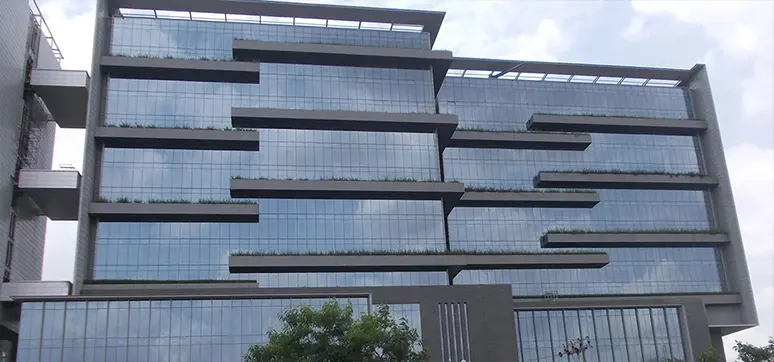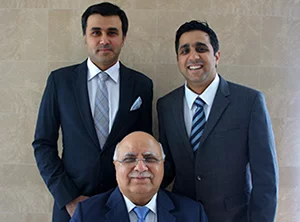Established in 1964, Consolidated Engineering Company (CEC) has grown from a small-scale manufacturer of aluminium hardware to one of the largest players in Façade Systems in India. It had been slow and steady growth over the years, working with some of the leading architects, and consultants, associating with numerous prestigious and landmark projects in India. WFM brings you the edited excerpts from the interview of Rajeev Shamlal, Arjun Shamlal and Rishi Shamlal, Partners of Consolidated Engineering Company (CEC), detailing their business and future plans along with potentials and opportunities in the façade industry in India.
WFM: Please tell us about yourself and about your company Consolidated Engineering Company (CEC)?
Rajeev Shamlal: Consolidated Engineering Company (CEC) was established in 1964 by my father Shri Shamlal. I joined the company in 1976 after doing my Chartered Accountancy, my elder son Arjun joined the company in 2003 after completing his masters from London School of Economics and my younger son Rishi joined the company after completing his MBA from the U.K. in 2005.
Consolidated Engineering Company (CEC) initially started with the manufacture of aluminium hardware in the 60s and in the 70s started promoting the use of aluminium doors and windows. In the 80s we got the opportunity to design and build one of the first curtain wall glazing for the Life Insurance Corporation of India at New Delhi. We had the privilege of working with renowned architect Charles Correa. With the help from consultants from England, we did the work for LIC which even today stands as a landmark in New Delhi. Thereafter we got the opportunity to design and build curtain walls for the ITC Centre at Russel Street, Calcutta and the office for SAIL, Calcutta as also one of the first intelligent buildings for the Computer Maintenance Corporation of India at the Bandra Kurla Complex, Mumbai in 1991-92.
With the opening up of the economy in 1992 as also the real estate sector being thrown open to private developers we started working with various leading developers of the time. In fact, we did all the work for DLF from 1992 to 2001 for their residential and commercial buildings with renowned architect Hafeez Contractor. In 1996 we were the first to introduce the concept and use of Aluminium Composite Panels (ACP) at the DLF Corporate Park, Gurgaon from Alucobond, Singapore.
Later, after my sons joined the company we have worked and are working with some of the leading architects, and consultants and have been associated with numerous prestigious projects
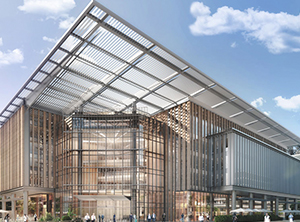
WFM: Please give us a brief background of your product and services.
Arjun Shamlal (AS): We at Consolidated Engineering Company have a wide variety of systems for both residential and commercial segments that have been developed in-house over the years. With respect to market segments we currently cater to the mid to the high-end product categories.
For the residential sector, we cover the entire spectrum of products such as sliding doors and windows, openable doors and windows and other allied product items. Our systems are flexible; that is to say, changes can be incorporated within the existing system design to meet specific project requirements such as wind loads, opening sizes, 2/3 tracks, tilt and turn, etc. Most of our systems are laboratory and site tested. Recently we have also tied up with international system suppliers such as Schueco, and SAPA and are in talks with others as well on a project-specific basis.
With regards to the commercial portfolio, here too we have a wide range. Here our products in addition to the standard curtain wall glazing systems (conventional and glazed) include bespoke unitized curtain wall glazing systems that can incorporate various materials such as stone cladding, aluminium sheet cladding, terracotta tiles, etc besides glasses of varying thickness. Some of our unitized glazing products are tested to wind loads up to 4 kph which were earlier unheard of in the industry. In addition to these, we have products for aluminium cladding, zinc cladding, various types of frameless glazing such as fin-supported spider systems, entrance façades, skylights for atriums in various materials such as glass, and polycarbonate. We also have executed the largest free supported cable net system spanning 17 meters by 32 meters high. In this segment too our products are laboratory tested to ensure quality.
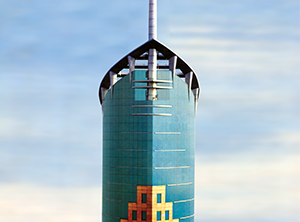
WFM: Where is your manufacturing facility located? Brief on the machinery you use?
Rishi Shamlal (RS): We currently have three facilities, two in the north – Sohna and Faridabad – and one in Hyderabad. The Hyderabad facility is an assembly facility that is for servicing the Southern and Western markets. The facility at Sohna is for manufacturing doors & windows and glazing-related products whereas the Faridabad facility is for sheet metal and ACP works. Together with these facilities, we have been able to service both the Northern and Southern markets. Our machineries are all state-of-the-art CNC for both aluminium and ACP. Currently, all our cutting and machining works are automated. Talking volume-wise, we can easily manage 250,000 ~ 300,000 sqm of glazing and allied projects and about 300,000~400,000 sqm of ACP and sheet metal works a year. With these facilities we have been successful in executing projects in Hyderabad, Chennai, and Kochi besides the NCR.
WFM: Please tell us about your company’s strength and ability to compete against other local and national suppliers?
AS: Strengths are many, starting with our people and commitment to work. We are one of the few companies that have been able to scale in relation to the growing demands. Working with automated machines and processes helps drive costs down, as labour is a significant part of our costs. Design is another aspect where we differentiate from other players in the market. In fact, we have a dedicated design and engineering office that is separate from our head office. Even though our projects are customized for each client, we are able to make small iterations of our products without compromising on the quality or project timelines. Coming to execution, we have a project model that is scalable depending upon project requirements and timelines allowing us to work with multiple clients simultaneously. Our suppliers also deserve a lot of credit as they too have helped drive down costs making us competitive.
WFM: Now you have grown in one of the largest players in Façade Systems in India. How did you achieve this?
AS: Firstly, thanks for the compliment. Obviously being one of the oldest and most experienced companies in the industry helped. We have achieved this slowly but surely. It has been slow and steady growth for us. There are not many companies in the market today that have been in operation for 15 years and have consistently grown. We could not have achieved this without our team that between them have considerable experience in all aspects of a project cycle, be it design, manufacturing, supply chain, quality and project management. During this growth, we never looked at running after contracts or numbers, our priority has always been to ensure good quality work with timely completion, and the rest came on its own. Most of our customers are now repeat customers. During the course of the years, we have invested heavily in our infrastructure whether be it in improving our manufacturing capacities, automating certain processes or investing in our project management techniques along with site equipment. Another factor was that we were able to translate all our experience and were able to scale our work to meet the growing demand.
WFM: You have achieved a lot and are considered one of the top facade contractors. What is your USP?
AS: When we take on a job, we take it seriously. The first thing to do is to sit with the architect, facade consultants, and the client and ask them what they want. Timelines are very important. At the same time, architects and designers do not like to compromise on design, especially when they are putting a lot of money into it. Understanding the client’s needs, consultant’s and architect’s requirements and expectations are very important. It’s only after that we go to the drawing board and start our work.
While designing a project, the easiest way is to try and save on material consumption or cost; but this is a very simplistic way to approach design. There are various other factors that are equally, if not more, important such as how much time you can save while procurement, fabrication, installation etc. You can design a very complicated system on the drawing board, and feel that with it you can save a lot on materials and hence money, but in the end, you will probably end up spending more money and energy while implementing it. Our team has design simplicity and practicality ingrained in its DNA. We keep in mind fabrication and installation ease, transportation, logistics and various other non-material factors when designing the final product. This way we can ensure a quality product that can be factory fabricated and sent in knockdown condition to the site for final assembly. We ensure that the factory not just manufacturers but also handles, packs and ships the material suitably. After that it’s logistics and making sure the same philosophy is replicated at the site.
WFM: What according to you are the potentials/opportunities for the fabrication industry in India in the near and the long term?
AS: I feel the Indian façade industry is just taking off. If you really think about it, the kinds of projects that you see today were unheard of as late as probably 2003. Earlier developers, builders were happily building one or two buildings a year. Now most major developers are doing multiple simultaneous projects nationwide.
Earlier façade contracts were in the range of 3~5% of the overall construction cost, now this share has increased to anywhere between 10~15%. There are times when the façade contract is the second largest contract after the main civil contracts. Obviously, the quantum of work has increased but another significant change has been that developers have started understanding the importance of façades and how it can contribute to reducing the life cycle cost of the project. This could not have been possible without the façade consultants who have played a crucial role in educating the clients on the advantages of a well-designed and executed façade system.
With towns being transformed into cities and cities expanding horizontally and vertically, the industry is heading towards an upturn.
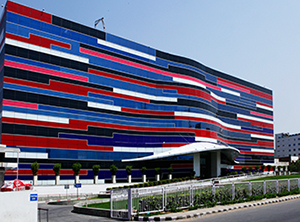
WFM: How do you assure the quality of your products?
RS: Quality is a very important aspect of our business. It is eventually what the client or the end user sees. Quality is controlled over the entire project cycle starting from not only choosing the right vendors/suppliers, using the correct machinery, training of assembly and installation crews to physical inspections, documentation etc. Façade performance testing plays a crucial role in ensuring that the product designed and installed is of a high standard. With performance testing, a lot of the problems in the project can be foreseen and resolved before starting the work. Before starting the production we lay out the quality standards expected from our works and encourage all the stakeholders i.e. clients, architects, and consultants to actively provide their inputs. Once the quality parameters and expectations are defined then it is simply a matter of following the right processes.
WFM: Tell us about a few of your important projects and future plans and ventures.
AS: Since its inception Consolidated Engineering Company (CEC) has been associated with many landmark projects starting from the first curtain wall glazing at the LIC, New Delhi or the first intelligent building at Bandra Kurla for CMC or the first ACP sheet installed in the country at DLF Corporate Park with Alucobond. Recently some of the landmark projects designed and executed by us include the Airtel Head Office with the coloured backlit façade glass and the free-standing 32-meter tall tension façade, Worldmark, MFT with Unitized CWG of 43mm thick triple acoustic laminated glasses and 50mm thick sandstone inbuilt into the unitized façade. Others would be the unitized CWG designed to withstand wind pressures up to 4.5 kpa at Two Horizon Centre, Gurgaon and the Trident Hotel, Hyderabad. We plan to leverage our experience and increase our footprint in the county to include more market segments and geographies
WFM: What is the importance of façade consultants and please name a few façade consultants you are working with?
AS: As recent as the early 2000s, façade consultants were unheard of in the industry. It was the architects and the fabricators who were primarily responsible for the façade design and engineering. A lot has changed since then. Now with projects becoming increasingly complex, façade consultants have become the norm on most projects. They bring a lot to the project whether it is educating the clients on the importance of a good façade system, explaining the merits of performance testing and or helping specify international grade materials and specifications. They also contribute by ensuring the project delivered to the client is of the highest standard and quality with their regular factory and site inspections. We have worked and are working with most of the top façade consultants in the country such as Meinhardt, Axis Façade, Priedemann, Façade India Testing, DEMA, Global Façade Systems and Aurecon (Singapore).
WFM: The organized Facade industry in India is a new one and not older than 20 years. Please discuss the changes seen by this industry in the past 10-15 years. How can we catch up with the technology happening in Western countries like photovoltaic-integrated building facades?
AS: The façade industry has undergone through major transformations in the last 10 years. A lot of large players that were at one time considered to be the industry standard have either scaled down their operations or in some cases have shut down completely. This is because the entry barrier to the business is very low and hence a lot of developers started their own in-house units. Once the real estate industry took a downturn then most of these companies wound up. Coming to your question regarding the introduction of technology like photovoltaic integrated facades, the government has to take the initiative to promote its use via its policies as currently they are prohibitively expensive. The last time something like this was done was with glass when the entire industry and its partners came together to encourage the use of Low-E glasses and the concept of building ratings was introduced. At another level, the basics of façade design and engineering need to be taught at the university level along with other aspects of building construction as the level of knowledge is very low and this needs to change. Industry forums and magazines like yours also help in spreading knowledge and can act as a platform for developing the business.
